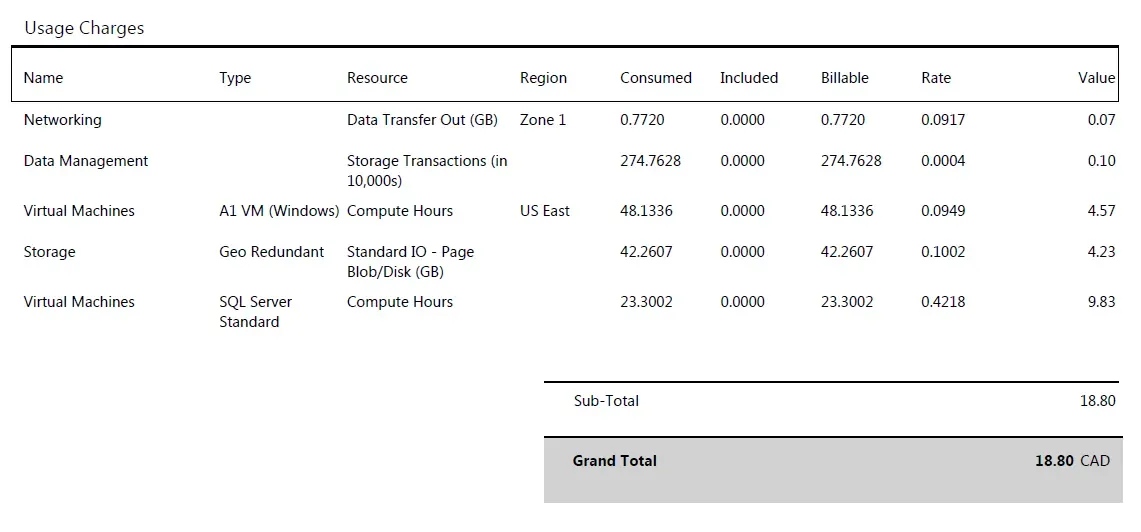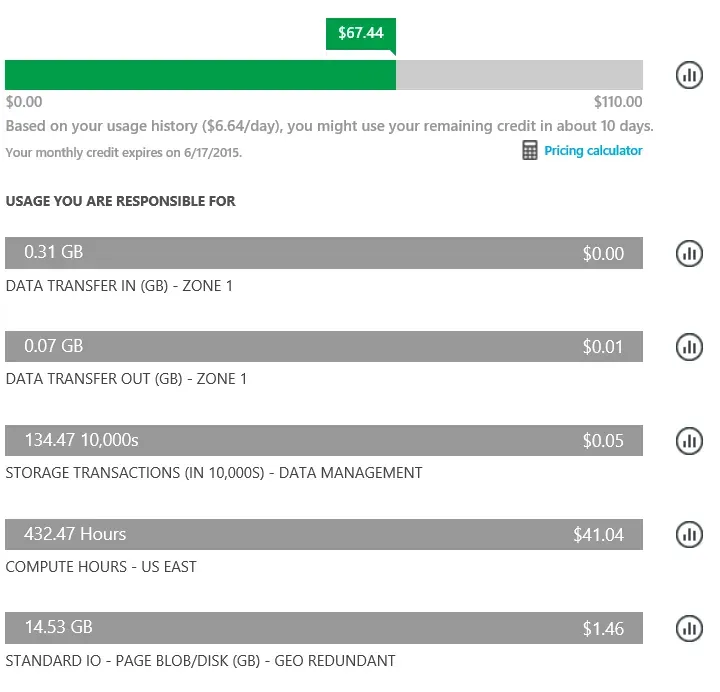This is officially the last post, for the foreseeable future, on my experiences with Azure. There isn't a ton of meat in this one, as it's more of a "what's happened since the last post" type of post.
Since the last post
I've done everything I said I would do at the end of my last post:
- I moved my previous Azure VM's GP installation to this new VM and ran into nothing exciting.
- I installed Management Reporter (now that I have a domain controller - yay!) and have migrated my FRx reports
- I waited a while to make sure everything ran smoothly and then deleted my old VM and old cloud service that was associated with it
The "invoice"
At first, I was a little alarmed when I got an email saying my invoice was ready! What?
After my minor freak-out, I realized it's just an official summary of the charges which in my case are fully "paid for" by my partner credit.
The best part about the invoice is that it summarizes usage for that period. The usage details, well, are details and to get totals one would have to summarize them themselves. My only complaint? The invoice date is 3 weeks after the end of the period so it's pretty slow to get a summary if someone wants timely information on this. Better to create a macro to summarize the usage details which are available much sooner.
Here is what the summary section looks like:

I love the graphic one gets during the period of what has been used (such as what I post below in the next section). Once the period is done, that is no longer available, and after about 3 weeks, this is what one gets which is the closest thing to the "current period" summary that I can find.
Running a machine 24x7
At the end of the last period, I changed to a plain old Windows machine with the O/S only. I installed my own SQL Server license, and Dynamics GP 2015 (and now Management Reporter 2012). I hadn't yet let the machine run for more than a day, not being ready to take that leap yet at that time.
This usage is for the current period starting with 05/18. Since 05/21, I have left my VM on full time 24x7 so it's been running for 4+ solid days and, of course, wracking up the costs more quickly. However, I'm happy to see it's not depleting my account as much as I had expected. Once again, storage costs are minimal, the majority of my cost to date is the VM itself. I'm running an A3, 4 core 7GB memory machine. My "real" run-time is about 108 hours, not 437 hours because the charge is multiplied by the number of cores on the server.

My thoughts on the experience so far
By my math, 1 day of usage for a 4-core machine is 96 compute hours. Averaging out the VM cost above, it appears to be a little over $9 a day to run this machine, not including the other types of charges, which are pretty minimal based on my usage so far. If I leave my VM turned on, I'll run out of credit before my period expires, but realistically, I'm happy with what I can get from the partner credit. I could run a machine as much as say 10 full days a month for free.
As a partner looking to use this for demos or troubleshooting client situations, I can turn this on and off at will pretty easily, so I don't have to spend more than my credit each month. I have downloaded an app for my iPhone and iPad that allows me to turn it on or off remotely, without logging into Azure itself. That is convenient if I want to get to work on something as soon as I get to my next destination (without waiting for it to be turned on first) or forget to turn it off after a working session. That's great…
So far, the learning curve hasn't been that bad. I overestimated the difficulty of using Azure. I know there is a ton more to learn but try it. Apart from a couple of minor hiccups that are different from say Hyper-V, it's no different from any other VM someone may have used in the past.
Previous articles in this series
- Part 1 - how this series started, setting up an Azure subscription, step-by-step how to set up a virtual network and VM
- Part 2 - change of approach, connecting to the VM, copying files, SQL config changes for GP, SQL collation problems when copying in my previous GP data, cost update
- Part 3 - cost update and details on how the charges are derived, performance to date, the Temporary storage, printing & GP upgrade
- Part 4 - cost update, RDP settings & local drives, VM sizes, Free Trial recommendation
- Part 5 - cost for the first month and what's next plans
- Part 6 - creating a new VM & domain controller, figuring out the Cloud Service, deleting VMs, Static IP addresses

